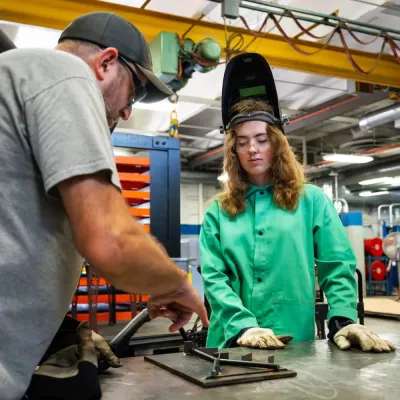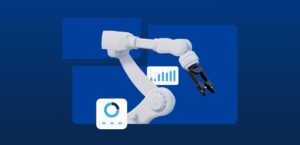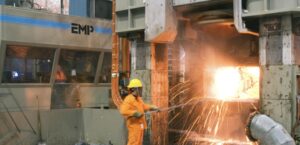Tech, Talent, & the Trades: Modern Systems for a Stronger Workforce

Tariff disruptions. Market uncertainty. Five generations of employees working under one roof. Broader economic and demographic shifts are challenging organizations to adapt to a constant state of change. As the workforce continues to evolve, manufacturers must take a holistic approach to their talent pipeline and consider how their people and technology work together to drive long-term success.
An estimated 1.9 million manufacturing jobs may go unfilled between 2024 and 2033, factoring in new legislation such as the CHIPS Act, retirements, and projected industry growth. The challenge isn’t just meeting productivity needs; it’s also engaging young professionals to build lasting careers in manufacturing.
Modernizing technology can play a pivotal role. Updating tech environments helps manufacturers attract new professionals, engage their current workforce, and adapt to future workforce transitions.
Attract the Next Generation of Professionals
Up-and-coming Gen Z professionals are increasingly interested in blue-collar careers in areas like plumbing and carpentry due to rising college costs and the desire for lucrative, secure jobs. Yet this renewed interest in the trades has been slow to transfer over to the manufacturing sector.
Misconceptions about antiquated technology have also steered many Gen Z workers away from the industry. As a tech-savvy generation, they expect digital work environments, and paper-based and aging legacy systems fall short of those expectations. 70% of Gen Z would leave their current role for better technology, compared with 52% of Gen X and 37% of baby boomers.
Modern systems can be a strong differentiator for attracting new talent for several key reasons:
- Innovative Employer Brand: Investing in updated tools signals a forward-thinking culture that appeals to top talent.
- Opportunity for Skills & Career Development: Gen Z values continuous learning and hands-on experience with the latest technology.
Limited exposure to manufacturing careers also affects young professionals’ decisions to enter the field. Early talent development programs, such as those led by the SparkForce Foundation, help ensure manufacturers have a deeper bench of skilled professionals in the years ahead. Programs that introduce students to innovations on the shop floor help reinforce manufacturing’s appeal to emerging talent.
Beyond recruiting fresh talent, cutting-edge tech environments also help improve workplace experiences for existing team members. With access to the right tools, employees are more engaged and likely to stay.
Keep Current Employees Engaged
A company’s tech environment impacts employee engagement and retention. This is especially true for frontline employees in production, fabrication, assembly, and warehouse roles, which are positions with historically high attrition rates. In a recent study, PwC found:
- Manufacturers Are Experiencing Frequent and Costly Turnover: 36% of companies have frontline employee turnover rates greater than 10%.
- Technology Directly Shapes the Employee Experience: 49% of workers shared “ease of use in systems and technology” was a top factor in creating a positive work environment.
Tedious and manual processes can cause even the most dedicated employees to disengage. Automating and streamlining workflows has a tangible impact on morale and retention. We’ve witnessed this effect firsthand. After upgrading their ERP, Jessica Beijaerts, plant manager at Holmatro, said, “I’m sure productivity has increased, and we’ve seen many other benefits. But most importantly, our employees are happier as a result of our upgrade to CSI 10.”
Adapt to Changing Workforce Dynamics
Demographic shifts are reshaping the manufacturing workforce, forcing companies to plan proactively for retiring employees. These changes create key concerns for organizations:
- A Growing Wave of Retirements: In 2024, over 25% of the individuals employed in manufacturing were 55 or older. As more employees transition out of the workforce, companies are left to compete for a shrinking talent pool.
- Expertise and Skill Loss: Rising retirement rates put teams at risk of losing critical institutional and technical expertise. 97% of companies are at least somewhat concerned about the brain drain resulting from increasing retirements.
One of the most effective ways to support smoother transitions is to unify systems, standardize workflows, and centralize documentation. Connected technology preserves organizational knowledge and reduces the ramp-up time of new hires by providing access to current and accurate information.
Support Employees at All Stages
With advanced tech stacks, employers not only reap productivity gains and cost savings but also tackle three of the largest workforce problems facing manufacturers today: attracting new talent, engaging current employees, and facilitating workforce transitions.
While structural and external factors continue to influence the talent shortage, technology provides a clear pathway to building a future-ready workforce.
Fueling Growth for Manufacturers, Today and Tomorrow
We believe a career in manufacturing should be accessible to everyone. This December, we’re celebrating our clients by making a donation in their name to the SparkForce Foundation.
Backed by the Fabricators and Manufacturers Association, SparkForce expands pathways into manufacturing through academic scholarships and hands-on summer camps. Students who receive Spark Force scholarships report being able to lower indirect college costs such as transportation and food (82%), reduce overall student loan debt (64%), improve focus on school due to fewer work hours (57%), boost their confidence in completing the program (45%), and graduate on time (36%).

“The scholarship was of great impact because I was having trouble deciding what I was passionate about and now I know what I want to do.”
SparkForce Scholarship Recipient, 2024 Impact Study
Thank you to our clients for making this work possible. This donation will create two scholarships for students and help fund additional early-talent development programs. Together, we can shape the next chapter of American manufacturing.
More About the Author: Sam Frumboli
With over 15 years’ experience partnering with businesses in the ERP and manufacturing sector, Sam has made it a passion of hers to help connect businesses with the right business partner, tools, and technology. As a demand generation leader, business coach, and freelance marketing consultant for start-ups and established brands, Sam focuses on dismantling complex ideas into actionable insights through creative marketing strategies and tactics. She has notably been featured in the Sociable, Women in Manufacturing, 40-Under-40, The Global Interview, and Forbes.
Similar Blogs

December Decision Digest

November Decision Digest






